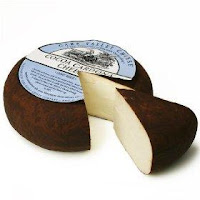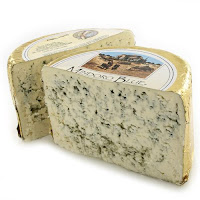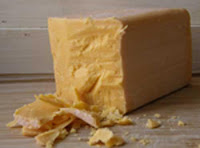About a century ago, immigrant cheese makers from Germany, France, Switzerland, Holland, Italy and Scandinavia, settled the area and starting making their Old World cheese. They applied traditional European cheese-making skills to the plentiful supply of wholesome milk found in Wisconsin. In 1841, Mrs. Anne Pickett made cheese-making history when she established Wisconsin's first cottage industry cheese factory using milk from neighbors' cows. Swiss cheese was one of the first specialty cheeses developed here with production beginning in Green County in 1869. Italian immigrants also did very well, making cheese reminiscent of their native homeland, outstanding Parmesans, Romanos, and Asiagos. The French contributed, Blue, Camembert and Brie. The Germans brought Muenster and Limburger, the Scandinavians Havarti and Bondost-Primost, while the Dutch provided Edam and Gouda. I'd say that pretty much covers the list of the classics and today, artisan cheese-makers in Wisconsin are taking that craft and skill into the 21st century bringing wonderful and creative twists to Wisconsin Affinage.
 By the 1920s there were over 2800 cheese factories in Wisconsin. In 1921, Wisconsin became the first state to grade its cheese for quality. This leadership role in quality assurance coupled with Wisconsin's central location for distribution enabled the industry to continue to grow rapidly. By 1922, more than 2,800 cheese factories existed in the state. Wisconsin has obviously benefited from the practices and traditions of the early European settlers, continuing their cheese making techniques in Wisconsin to this day. But even with the multitude of delicious cheeses that can be traced to Europe, numerous varieties, such as Brick and Colby originated in Wisconsin. Over the years, this special cheese making heritage, blended with expertise and modern technology, has laid the foundation for Wisconsin to have the most stringent cheese making standards. To maintain its hard-earned reputation, Wisconsin became the first state to require cheese grading and licensing of its cheese makers. Even today, no other state has standards higher than Wisconsin's.
By the 1920s there were over 2800 cheese factories in Wisconsin. In 1921, Wisconsin became the first state to grade its cheese for quality. This leadership role in quality assurance coupled with Wisconsin's central location for distribution enabled the industry to continue to grow rapidly. By 1922, more than 2,800 cheese factories existed in the state. Wisconsin has obviously benefited from the practices and traditions of the early European settlers, continuing their cheese making techniques in Wisconsin to this day. But even with the multitude of delicious cheeses that can be traced to Europe, numerous varieties, such as Brick and Colby originated in Wisconsin. Over the years, this special cheese making heritage, blended with expertise and modern technology, has laid the foundation for Wisconsin to have the most stringent cheese making standards. To maintain its hard-earned reputation, Wisconsin became the first state to require cheese grading and licensing of its cheese makers. Even today, no other state has standards higher than Wisconsin's. Today, approximately 15,000 dairy farms, with over 1.2 million cows producing an average of 18,850 pounds of milk each per year, continue the reputation for quality milk from Wisconsin. Cheese-makers use approximately 90 percent of this milk to produce cheese at 115 plants.
Today, approximately 15,000 dairy farms, with over 1.2 million cows producing an average of 18,850 pounds of milk each per year, continue the reputation for quality milk from Wisconsin. Cheese-makers use approximately 90 percent of this milk to produce cheese at 115 plants.Wisconsin has more skilled and licensed cheese-makers than any other state. These cheese-makers must complete rigorous studies in dairy science and cheese-making before they can be licensed. They also may serve as an apprentice under a licensed cheese-maker. Additionally, Wisconsin is the only state to offer a Master Cheese-maker program, patterned on the rigorous standards of similar programs in Europe. These fine craftsmen produce over 2.4 billion pounds of cheese each year, over 25 percent of all domestic cheese. These quantities continue to grow to meet the nation’s demand for quality and variety of cheese from Wisconsin, America's Dairyland.
In today's' selections, since there are so many cheeses offered, I have provided links for you to use at the bottom of the page, but I'll cover some of the top Award Winning cheeses from this prolific dairy state. Wisconsin is also home to more than 70 farmers’ markets. For a listing of the top 5 markets, visit, www.travelwisconsin.com. The one I have highlighted here is the largest outdoor market in Milwaukee.
 Fondy Farmers’ Market, Milwaukee
Fondy Farmers’ Market, MilwaukeeBringing healthy, affordable food to this diverse Milwaukee neighborhood, the Fondy Farmers’ Market is the city’s largest outdoor market. Much of the abundance you’ll find here is grown by Hmong farmers. 7 a.m.-4 p.m., Sat.; 9 a.m.-3 p.m., Sun.–Thurs. 2200 West Fond du Lac Ave., Milwaukee; (414) 933-8121, fondymarket.org.
The Cheeses
This Wisconsin cheese was the winner of the American Cheese Society 2002 best-in-show award. Wisconsin Benedictine Cheese is made from cow, goat and sheep's milk, giving it a complex flavor with a wonderfully full finish and a rich and creamy texture. Best In Show American Cheese Society 2002 Second Place ACS Cheese Competition, 2006
 Black River Gorgonzola
Black River Gorgonzola This award winning Gorgonzola is true to its Italian roots. It is a very robust and tangy blue cheese with a mild aftertaste. It has a firm yet crumbly texture with greenish blue mold in veins and pockets. Wisconsin State Fair 2006 Second Prize, Blue Veined Cheeses Wisconsin State Fair 2005
 Carr Valley Black Truffle Sheep's Milk
Carr Valley Black Truffle Sheep's Milk Black-truffle cheese is made from cow's and sheep's milk with the addition of small pieces of black truffle. This cheese is a semi-hard, sharp cheese with intense truffle flavor. Ingredients are: Milk, culture, rennet, salt. Third Place, Open Category, Sheep's Milk, American Cheese Society, 2006.
 Carr Valley Cheddar Snow White Goats Milk
Carr Valley Cheddar Snow White Goats Milk A creamy white Goat Cheddar Cheese made in 38 wheels and cave aged for 6 months. 2nd Place at the 2007 American Cheese Society Competition and 2008 Best in Show at American Cheese Society.
 Carr Valley Cocoa Cardona
Carr Valley Cocoa CardonaChocolate and cheese unite beautifully in this award-winning American Original. Delicious Cardona aged and rubbed with cocoa powder. The cocoa flavor is subtle, the rind a lovely brown, and the end result like nothing you've ever tasted. Made from 100% goat's milk. Located in central Wisconsin, Carr Valley cheese remains one of Wisconsin's traditional cheese plants, famous for its cheddar varieties made the old-fashioned way. Owned and operated by the Cook family, Carr Valley will celebrate its 100th anniversary this year. Cocoa Cardona won 1st Best of Class in the U.S. Cheese Contest in 2003. Awarded 1st Place in the 2007 American Cheese Society Awards in the Open Category for Goat's Milk Cheeses.
Cheddar Raw Goats Milk
Mt. Sterling Cheese Co-op offers this mild natural cheddar style Wisconsin goat's milk cheese. It's made from raw, not pasteurized milk, then aged a minimum of 60 days. The raw goat milk is not pasteurized in the cheese-making process, only heat-treated. A more piquant taste than the raw milk cheddar, raw goat?s milk cheddar is cheese al gusto. Bronze World Championship of Cheese 2002, Second Place, ACS Cheese Competition, 2006
Decatur Dairy Havarti with Dill
 Decatur Dairy is an award winning cheese producer from the Brodhead, Wisconsin area. Steve Stettler and his talented team produce a wide range of championship cheeses, including cheese curds and string cheese. Steve has been a cheese-maker since 1974 and holds the Master Cheese-maker professional accreditation.
Decatur Dairy is an award winning cheese producer from the Brodhead, Wisconsin area. Steve Stettler and his talented team produce a wide range of championship cheeses, including cheese curds and string cheese. Steve has been a cheese-maker since 1974 and holds the Master Cheese-maker professional accreditation. Their Havarti, one of the fastest growing cheese varieties in terms of popularity, won Second Place in its class at the World Championships in 1998, 2nd at the US Championships in 1999, and 1st place at the 2000 Wisconsin State Fair. His Dill Havarti won First Place at the 1999 Wisconsin State Fair, and Third at the World Championships in 1998. And his Muenster won Best of Class at the World Championships in 1998. The World Championships are held every two years and attract hundreds of master cheese-makers from all over the globe.
 Decatur Muenster Stettler
Decatur Muenster Stettler This Stettler Muenster is firm, creamy and provides that bite that you expect from a good Muenster. Also known as Munster or Muenster, this cheese is a mild cheese, known for its orange coloring on the outside. 2008 First Place-World Contest, Muenster 1998, First Place-World Contest Muenster.
Holland Family Farms 1 Year Old Gouda Marieke
Hard and nutty, this extra aged Marieke Gouda has developed milk crystallization deposits throughout. Crunchy and extremely flavorful, a wonderful example of aged Gouda. Rolf and Marieke Penterman emigrated from the Netherlands in 2002 to pursue their passion for dairy farming. The cheeses are smooth, creamy Gouda cheeses with a slightly sweet, nutty flavor that becomes more complex as it ages on wooden shelves. Aged at least 9 months 2007 - Marieke's Foenegreek Gouda voted "Best of Class" in the Wisconsin Cheese Makers Association United States Championship Cheese Contest . 2008 - 2nd place in the 2008 World Championship. 2008 American Cheese Society- 1st and 2nd Place Dutch Style.
 Maple Leaf Cheddar English Hollow
Maple Leaf Cheddar English HollowThe region that is home to the Maple Leaf creamery is known as English Hollow because of the large number of dairy farms started by English immigrants. This cheese takes its name from the region. Twelve months of aging give this English cheddar a pleasantly complex flavor. 2008 World Champion 1-Year Aged Cheddar.
Mindoro Blue
Swiss Valley Dairy specializes in Blue-veined cheeses including Gorgonzola. Mindoro Blue is a drier and stronger version of their Gorgonzola. Their manufacturing facility for blue-veined cheese is located in Mindoro, Wisconsin, in the southwestern part of the state. Mindoro Plant Manager, Richard Glick, is a certified Wisconsin
 Master Cheese-maker. Mindoro Blue and Gorgonzola are premier cheeses in their categories and have won numerous awards. Recent awards include: Third place, Blue cheese, National Milk Producers Federation, 2006 Third place, Blue cheese, World Dairy Expo, 2005 Third place, Blue cheese, World Cheese Awards (London), 2004.
Master Cheese-maker. Mindoro Blue and Gorgonzola are premier cheeses in their categories and have won numerous awards. Recent awards include: Third place, Blue cheese, National Milk Producers Federation, 2006 Third place, Blue cheese, World Dairy Expo, 2005 Third place, Blue cheese, World Cheese Awards (London), 2004. Mobay
MobayMobay cheese is a Wisconsin Cheese made by Carr Valley. Made in two halves with ash in the center and outside. One half is made with goat's milk and the other half made is made with sheep's milk. An earthy flavor, but with a clean goat and sheep remnant. 1st Place Winner- Open Sheep Category, American Cheese Society Annual Cheese Competition.
 Pine River Horseradish Cheese Spread
Pine River Horseradish Cheese Spread Owned and operated by the Lindemanns, who have been making cheese dating back to the late nineteenth century, Pine River is where they produce award winning Wisconsin cold pack cheese foods (crock spread) and pasteurized processed Wisconsin cheese spreads. American Cheese Society 2006, Cheese Spreads, 1st Place. Must like horseradish, since this spread is powerful.
 Roth Kase Gran Queso
Roth Kase Gran Queso Similar to the Spanish Manchego. Made from the freshest cow?s milk, GranQueso? is handcrafted in limited quantities and carefully cured in their affinage cellars for six months. The distinctive basket-weave patterned rind with a reddish coat makes for an attractive presentation. 2004,2005,2006 American Cheese Society - 1st Place, 2005, 2006 World Cheese Awards - Gold Medal.
Roth Kase Gruyere Grand Cru
 This cheese is rich and creamy with a nutty aroma. French style raw milk Gruyere cheese. This cheese is cellar cured, washed rind, and hand made in small batches. World Champ: Gold In its Class, London 2004
This cheese is rich and creamy with a nutty aroma. French style raw milk Gruyere cheese. This cheese is cellar cured, washed rind, and hand made in small batches. World Champ: Gold In its Class, London 2004 Rothkase Roth's Private Reserve French style raw milk Gruyere cheese. This cheese is cellar cured, washed rind cheese had made in small batches. United States Champion Cheese 2007, First Runner
 Upland Creamery Pleasant Ridge Reserve
Upland Creamery Pleasant Ridge ReserveAn artisanal cheese made from the non-pasteurized milk of a single herd of Wisconsin cows fed and managed using natural, "old world" practices. The cows graze lush pastures from early spring through fall, just as all cows did before the industrialization of our food system. The resulting milk has better nutritional value and more varied and subtle flavors that are expressed in the delicate flavor profile of this cheese. Best In Show American Cheese Society, 2003 & 2005 (Only Cheese to Win This Award Twice) First Place: Class MA: Farmstead Cheeses, Open Category for Cheeses Aged Longer than 90 Days American Cheese Society, 2005 Best Of Class: Class 19. Smear Ripened Cheeses United States Championship Cheese Contest, 2005 Third Place: Class VC: Washed Rind Cheeses, Open Category Made from Cow's Milk ACS Cheese Competition, 2004.
 Widmer's Six & Nine Year Reserve Cheddar
Widmer's Six & Nine Year Reserve Cheddar Joe Widmer's family has been crafting cheese in Theresa, Wisconsin since his grandfather John Widmer arrived from Switzerland and settled in the heart of one of the richest cheese-making areas in America more than 80 years ago. Much like a limited edition book or lithograph, every piece of Widmer cheese is handcrafted in small batches to ensure quality. Joe just became one of only eight certified Wisconsin Master Cheese-makers in America. Their reserve cheddars are marked, labeled with a vat number and production date, then placed in special curing rooms to age. While curing, the cheeses are inspected and turned by hand at regular intervals. This six year aged cheddar is rich with notes of caramel. While it is aged for a considerable period of time, it is still moist and creamy on the tongue with a noteworthy tangy-ness and slightly salty finish. Awarded 1st Place in the American Cheese Society 2007 Awards in the Mature Cheddar: Aged Over 49 Months category.
I hope you enjoyed this look at some of the great cheeses being produced in Wisconsin. Next up, we'll be traveling to the Green Mountains of Vermont and taking a look at the great traditions, both old and new, from the prolific cheese producing state.
Bon Appetit,
Lou
Sources: Wisconsin Department of Tourism, http://www.wisconsinmade.com/ , www.wisconsincheesemart.com, food-fun.wisconsinfood.com, www.365cheeses.com , www.elegantfoods.net , www.igourmet.com, 






























